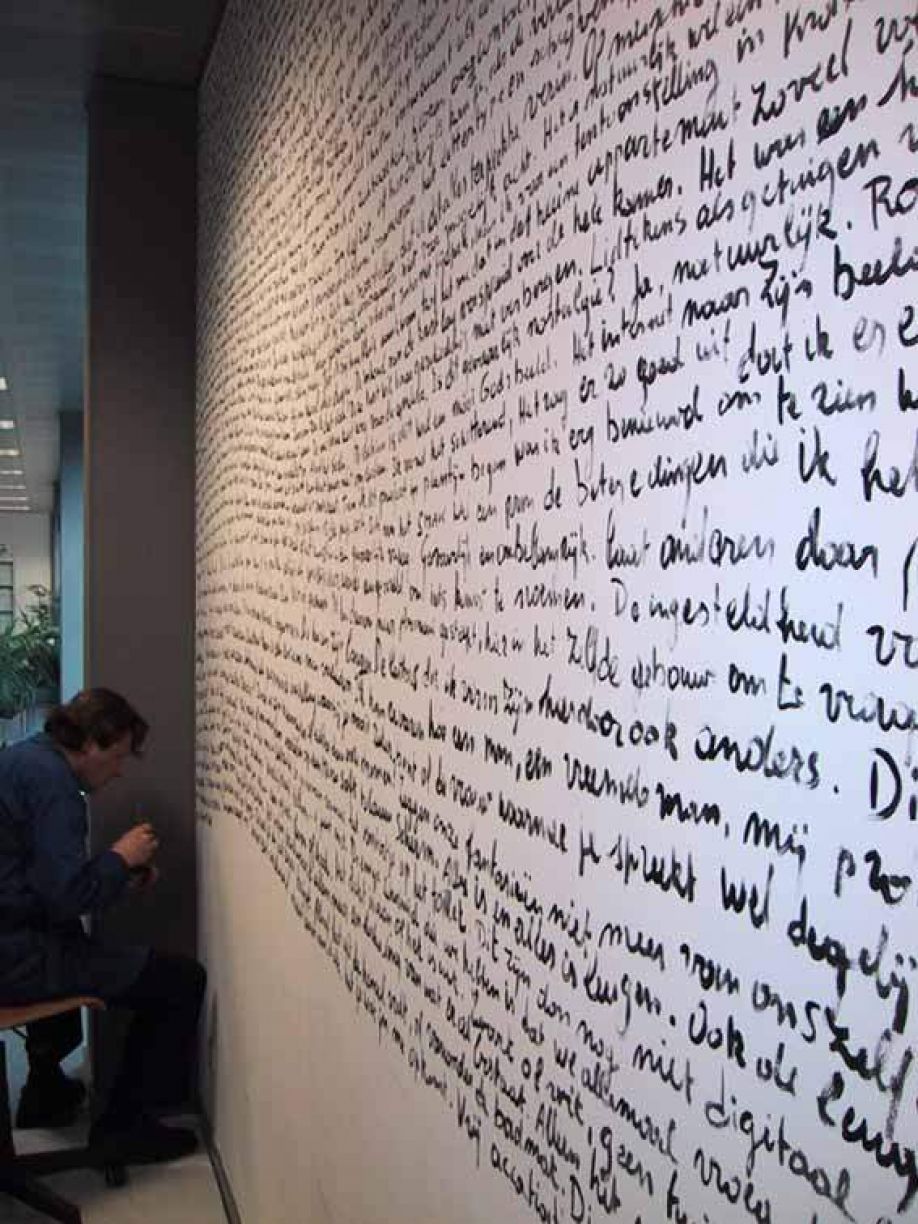OLYMPIA, OF HET SPOORLOZE LICHAAM VAN JOHAN PAS (2001)
Olympia, or the disappearing body
(By Google Translate)
Big words have many meanings. The name Olympia can, depending on the context conjure up images of the Olympic games, the legendary concert hall in Paris, the Riefenstahl documentary from 1936 of the same name or perhaps have associations with the actual saving scheme of Opel-Belgium.
Art lovers will probably think of Eduard Manet’s scandalous painting of 1863, office employees will see the famous brand of typewriters. This last association is the starting point in Pierre Mertens recent art integration project in the Plantijn College in Antwerp.
During his exploration prior to this project the artist found stored in an old college building a rack of redundant typewriters. One of his first actions in the new college building was to transfer this rack of dust-free, packaged typewriters to the library. The outdated machines, once potent symbols of progress are thus reincarnated. The ungainly physical presence of these quiescent, pre-digital machines contrasts strikingly with the dynamic – and intangible – contemporary information medium.
However the link with Manet is not too remote. When he exhibited his own Olympia this naked representation provoked a great scandal. Manet’s self-willed combination of the centuries-old and respectable Venus theme with the representation of a modern prostitute resulted in an artistic short circuit. The undisguised physicality of Manet’ s model, Victorine Meurent shocked the public. The collision of two frames of reference – idealized tradition and crude reality- created confusion and controversy. As a result of this tumult, the painter achieved the status of a modernistic pioneer, perhaps without aiming to do so.
Manet’s provocative confrontation of artificial idealism with natural realism provides an interesting analogy with Pierre Mertens’ emphasis on the tension between ‘the virtual’ and ‘the physical’.
In contrast to the classically-influenced citizen of the 19thcentury who was not ready for Manet’s physical naturalism are we now witnessing the retreat of physicality and the advance of virtual artificiality.
In Manet’s time modernity involved recognising the reality within that which was artificial.
Today the main attribute of contemporary life is the infiltration of the artificial into our physical perception of reality. This reversal is probably the essential characteristic of post modernism.
Not only is our relationship to physicality changing but also the perception of public space is in the process of evolving. When the city as a public environment was in full expansion Manet, Monet and other pioneers of the avant-garde created salons and alternative groups as their working space. Streets and squares of the 19thcentury metropolis were the domain of the academicians and the public space was filled with statues and monuments. Citizens of bronze, and marble virgins, embodied the communal ideals of technology and progress.
Today the public environment, and the art exhibited therein, shows a reverse movement. The public space now extends into that non physical space, which constitutes the World Wide Web.
The attitude of contemporary artists towards assignments in the public space is changing.
Pierre Mertens approach is, in this light, exemplary. He has opted in this project not for a striking centrally placed physical sculpture, but has developed over more than a year a peripheral circuit of 12 artistic interventions.
The function of the college as social and communicative space became the red line. Pierre Mertens’ interventions interweave in various ways with students’ and staff usage of the building. Contrary to traditional attitudes towards public space, Pierre Mertens’ representations are not punctuation marks in the interpretation of the building, but are accents.
At the same time the artist provides an inventory of traditional and current communication strategies.
The written and spoken words, collected objects and images, selected and digitally – manipulated photographs, a screensaver and a public chat box as billboard, all form the heterogeneous elements of a subtle network of comprehension. Experience the tension between the feelings of the individual and the power of the masses. The whole integration project can be viewed in a virtual walk on Internet or in the Cd-rom both of which were created as an invitation to the inauguration of the project. From his seat the virtual visitor can visit the abandoned Plantijn college. Effortless, noiseless and above all trackless. Like a phantom.
Johan Pas

